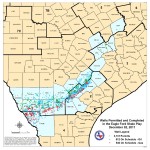While South Texas Sees Dollar Signs, Roads See Damage and Accidents

Photo courtesy of TxDOT
While the boom in South Texas has brought a time of economic plenty, it's putting a hurt on roads.
You don’t have to go far from Greg Sengelmann’s office in the center of Gonzales to see something’s different about South Texas these days. “That’s the city’s RV park that we put in, to house all the [oilfield] workers out there,” he says, pointing to dozens of motorhomes parked on a grass hill outside the J.B. Wells Arena (also home to youth rodeos and vintage airstream rallies). “You’ll see probably ten other ones throughout the county.”
Sengelmann is the General Manager for the Gonzales County Underground Water Conservation, tasked with managing and protecting the area’s groundwater. As drilling rapidly expands in the Eagle Ford Shale and other parts of Texas thanks to the spread of hydraulic fracturing (aka “fracking”) and horizontal drilling, it’s changing small towns and communities.
“I think it’s a net positive,” says Sengelmann. “I think people are mainly happy about it. Because it’s bringing in a lot of money and new activity.”
The questions are whether those changes are all for the better, and how long the money and activity will last.
A new economic impact study released Tuesday by the University of Texas at San Antionio’s Institute for Economic Development shows that the fiscal benefits of the boom are huge in the Eagle Ford Region, an oil-rich area about 50 miles wide and 400 miles long. Jobs? 116,000 of them, full-time, in 2012, the report says. Money? $61 billion in economic impact for the region last year, with more than two billion dollars in tax revenues for state and local government that year. In Bexar County, which includes San Antonio, drilling jobs quadrupled from 2011 to 2012. Locals can also get a cut, with at least $72 million paid out overall to landowners for land leases in 2012, according to the study. Royalties paid out to landowners, which are a cut of the oil and gas drilled, were estimated at the astronomical total of $3 billion.
All of this means more money for local coffers and greater economic prosperity for communities. But the boom is not without downsides, and at the top of the list is truck traffic and accidents.
There were 2,710 fatal and serious injury crashes and 248 traffic fatalities in 2012 in the Eagle Ford region, according to preliminary crash data provided by the Texas Department of Transportation (TxDOT). Traffic fatalities in the Eagle Ford saw an increase of 40 percent. Fatalities were also up in the Permian Basin drilling region of West Texas. Across the state, traffic fatalities were up ten percent in 2012.
“There’s been a lot more accidents in our county lately,” says Sengelmann. “And the county roads are really becoming beat up.”
Many of the county roads where drilling haulers are were built in the fifties, and not designed for today’s heavy, hulking trucks, which make multiple trips to drilling sites. TxDOT (which says it’s already cash-strapped) says the cost of repairing state and local road infrastructure from drilling damage is $4 billion a year.
According to TxDOT, just one oil or gas well using fracking requires:
- 1,184 loaded trucks to start production
- 353 loaded trucks a year to maintain production
- 997 loaded trucks every five years in order to re-frack the well

Photo courtesy of TxDOT
Truck traffic from drilling is causing serious damage in parts of Texas, like the oversized truck pictured here.
Doing the math, the agency says that just to frack a well, it’s like adding the traffic of 8 million normal cars to a road, then 2 million cars after that annually to maintain the well.
In Gonzales County, Sengelmann has observed routine patrols targeting improper or illegal trucking by the Department of Public Safety. “When they come into town, you can’t miss ’em,” he says, “And they stop these trucks all over the place. They’ll move up and down the Eagle Ford Shale to reign [truckers] in and make sure they’re complying with the rules.”
The Texas state legislature is considering several bills that would help alleviate the problem, as well as efforts to stop diversions from drilling tax revenues. One bill, SB 300, by State Sen. Carlos Uresti, D-San Antonio, would take money from the state’s Rainy Day Fund to help fix roads. “What my bill would do is [provide] one-time funding of approximately 400 million dollars to fix the county roads in those different counties,” Uresti said at a StateImpact Texas panel on fracking in February. “They’re just falling apart.”
State Sen. Wendy Davis, D-Fort Worth, has filed a bill, SB 941, that would require drillers to use “protective measures” to prevent road damage.
Neither bill has had a committee hearing yet.
The Railroad Commission of Texas, which regulates oil and gas drilling in the state, maintains that truck traffic doesn’t fall under their jurisdiction.
Some drilling companies, like Pioneer Natural Resources and Petrohawk Corp., have entered into voluntary agreements with DeWitt County to pay road repair fees for each well they drill there.
In the TxDOT presentation on road impacts from drilling, it was noted that it was less costly to proactively address the issues by strengthening and resurfacing roads before they are damaged by drilling than to do so after the damage has already occurred.
A task force on the issue led by TxDOT has also looked into having the industry pay for its share of damage, charging more for Commercial Drivers Licenses (CDL), and amending the tax code to allow counties to get more revenue from new oil and gas wells, increasing fines for overweight and oversized trucks, among other ideas.


